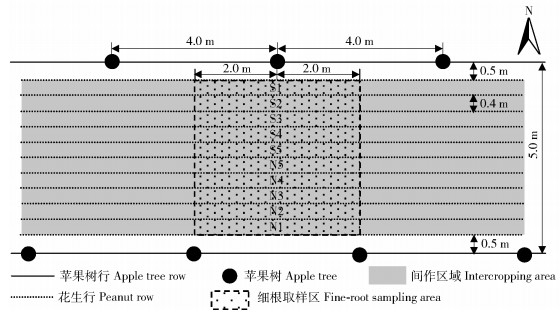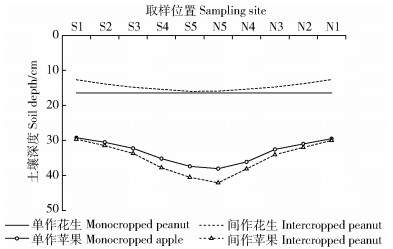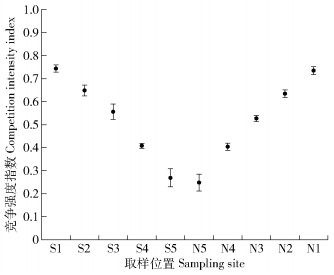2. 水土保持国家林业局重点实验室, 100083, 北京;
3. 北京市水土保持工程技术研究中心, 100083, 北京;
4. 林业生态工程教育部工程研究中心, 100083, 北京;
5. 山西吉县森林生态系统国家野外科学观测研究站, 100083, 北京;
6. 北京林果业生态环境功能提升协同创新中心, 102206, 北京
中国水土保持科学  2019, Vol. 17 2019, Vol. 17  Issue (1): 48-56. DOI: 10.16843/j.sswc.2019.01.007 Issue (1): 48-56. DOI: 10.16843/j.sswc.2019.01.007 |
农林复合经营具有控制土壤侵蚀、涵养水源及降低水土流失等水土保持效应[1],在晋西黄土区得到了广泛的推广和应用;同时,农林复合系统在协调农林“争地”矛盾,提高自然资源利用率,缓解人口与资源的矛盾以及农业增产和农民增收等方面起到了巨大的作用[2]。然而农林复合系统的这种优势可能被树木和作物之间的竞争所抵消[3]。充分地利用树木和作物的协同作用、尽量减少两者间的竞争、并最大程度地利用现有资源是提高农林复合系统产量和整体生产力的关键[4]。国内外学者研究发现,林木与作物通过根系在地下界面对土壤水分和养分的竞争较林木与作物通过空气在地上界面对光、热和气的竞争更为激烈[5-8]。特别是在干旱半干旱地区,农林复合系统种间地下根系竞争尤为激烈[9-11]。农林复合系统中树木和作物的细根具有适应土壤水分和养分异质性的内在能力[12]。开展干旱半干旱生境农林复合系统植物适应性研究是减少水土流失和恢复生态平衡的关键。一些研究发现,树木和作物的竞争减少了它们细根[11, 13-14],为响应种间地下竞争,树木的细根移动到更深的土壤中[7, 13, 15]或移动到更浅的土壤中[16],作物的细根移动到更浅的土壤中[14, 16]。根系形态变异对资源有效性和/或植物竞争的响应是植物根系避免竞争的主要机制[5, 17-18]。目前,对苹果(Malus pumila Mill)-花生(Arachis hypogaea L.)间作系统中苹果与花生细根形态变异对种间地下竞争的响应状况不清。
农林复合系统中树木和作物细根的空间分布和形态是决定系统生产力[19]和地下竞争程度[3]的关键因素。根据理论生态学原理,种间地下竞争发生在共用资源不足且两物种从同一土层获取资源时[20-21]。提高农林复合系统自然资源利用率的关键是林木和作物的根系在土壤空间上以互补的方式利用资源[5]。目前,常把生态位理论应用于量化农林复合系统种间地下竞争的研究。其中对杨树(Populus L.)-小麦(Triticum aestivum L.)复合系统的研究发现,距杨树林带1倍林带平均高内,杨树和小麦生态位重叠,在0.5倍杨树林带平均高内重叠度较大,种间地下竞争激烈[22]。对核桃(Juglans regia L.)-大豆(Glycine max (L.) Merr.)复合系统的研究表明,种间地下竞争的主要区域为距核桃树行1.0~2.5 m[23]。对枣树(Ziayphus jujuba Mill.)-棉花(Gossypium hirsutum L.)复合系统的研究发现在水平方向上距枣树0.1~0.3 m种间地下竞争最为激烈[24]。这些研究均在量化种间地下竞争的基础上提出了合理的田间经营管理策略,但对苹果-花生间作系统种间地下竞争的研究和相应的经营管理策略鲜见报道。
苹果是晋西黄土区主要的经济林林种之一,花生作为当地的主要油料作物之一,均具有较高的经济效益,常在晋西黄土区进行间作种植。但由于一些粗放的经营和管理方式导致苹果-花生间作系统各组分对地下资源竞争激烈,影响间作系统功能的发挥,降低间作系统的经济效益;因此,研究苹果和花生细根的形态变异和地下竞争状况,有助于了解苹果和花生对种间地下竞争的适应性策略,了解间作系统中苹果和花生之间的竞争机制,并采取进一步的经营管理措施来缓解苹果-花生间作系统的种间地下竞争。对苹果-花生间作系统各组分的细根形态变异及种间地下竞争状况进行研究,能为该地区苹果-花生间作系统的结构优化配置及种间关系调控提供科学依据。
1 研究区概况试验地位于山西省吉县水资源节约型农林复合系统试验示范基地(E 110°43′,N 36°01′),是典型的黄土高原残塬沟壑区,属暖温带大陆性季风气候。多年平均降水量571 mm,蒸发量1 729 mm,年均气温9.9 ℃,日照时间为2 563.8 h,≥10 ℃积温3 358 ℃,无霜期172 d。土壤以褐土为主,黄土母质,土层深厚,土质均匀。主要的间作果树有苹果和核桃,主要的间作作物有花生、大豆和玉米(Zea mays L.)。
2 研究方法 2.1 试验材料苹果树种植于2010年,花生于2017年4月播种。苹果树为品字型排列,且行向为东—西,株行距4.0 m×5.0 m,栽植密度为500株/hm2。苹果树平均树高3.7 m,胸径7.2 cm,冠幅3.9 m。距苹果树行0.5 m处种植花生,花生株行距0.3 m×0.4 m,栽植密度为8万3 333株/hm2。
2.2 试验设计试验包含3个处理:苹果-花生间作系统、苹果单作系统及花生单作系统。每个处理3个重复。各处理每个样地面积为12.0 m×15.0 m,其中苹果-花生间作系统每个样地包含14颗苹果树和间作花生,且持续与花生进行间作。单作苹果每个样地仅包含14颗果树,单作果树未与作物进行间作。单作花生每个样地仅种植花生。
本研究采用分层挖掘法对苹果和花生进行根系采样,并将<2 mm的根作为细根。如图 1所示,在苹果-花生间作系统样地和苹果单作系统样地内选择3棵苹果树作为标准木,在垂直于树行方向,并距苹果树0.5 m处,挖1条长4.0 m、宽4.0 m、深1.0 m的样带,水平方向每0.4 m为1个取样区,并将距果树行南侧0.5~0.9、0.9~1.3、1.3~1.7、1.7~2.1以及2.1~2.5 m标记为S1、S2、S3、S4和S5;距果树行北侧0.5~0.9、0.9~1.3、1.3~1.7、1.7~2.1以及2.1~2.5 m标记为N1、N2、N3、N4和N5。在花生单作系统样地内随机选取长4.0 m、宽0.4 m、深1.0 m的3个取样区。所有取样区均在垂直方向上每20 cm为1层对土体进行分层挖掘取样,每样方取4.0 m×0.4 m×0.2 m的包含苹果和花生根系的土体。然后用水小心地将根系与土粒分离,直至根系和泥土完全分离获得实体根系,挑拣活根,分别拣选出苹果树根系(黑褐色)和花生根系(浅黄色),然后用电子游标卡尺分选测量出苹果和花生的细根。将取得的苹果和花生细根放入烘箱中75 ℃烘至恒重,分别称质量并记录,于2017年9月23日花生成熟期(末)及苹果成熟期(末)进行测定。

|
图 1 苹果-花生间作系统细根核心取样区 Fig. 1 Core fine-root sampling plot of the apple-peanut intercropping system |
苹果和花生细根在整个垂直土壤剖面上分布是不均匀的,在每层土壤中可以认为是均匀分布的,可以用细根垂直重心公式来定量研究苹果-花生间作系统各组分细根的形态变异[14],公式为
| ${D_{{\rm{FRVB}}}} = \sum\limits_{i = 1}^n {{D_i}{P_\mathit{i}}} ; $ | (1) |
| ${P_\mathit{I}} = {n_\mathit{i}}/{N_ + }。$ | (2) |
式中:DFRVB为细根垂直重心所在的土壤深度,cm;i代表土层;Di为每个土层中部的深度,cm;Pi为第i土层的细根生物量密度ni占0~100 cm土层总细根生物量密度N+的比例。
2.3.2 竞争强度指数采用Pianka[25]提出的生态位重叠公式,该公式可以客观的反映出种群间的生态位重叠程度,可以用于计算资源短缺情况下种群对共用资源的竞争利用程度[26]。计算公式为
| ${A_{{\rm{AP}}}} = {A_{{\rm{PA}}}} = \sum\limits_{i = 1}^r {{P_{Ai}}{P_{\mathit{Pi}}}} /\sqrt {{{\left( {\sum\limits_{i = 1}^r {{P_{\mathit{Ai}}}} } \right)}^2}{{\left( {\sum\limits_{i = 1}^r {{P_{_{\mathit{Pi}}}}} } \right)}^2}} 。$ | (3) |
式中:AAP=APA为苹果-花生间作系统的竞争强度指数,且A≤1;PAi和PPi分别为苹果和花生在第i土层的细根生物量密度占各自0~100 cm土层总细根生物量密度的比例,计算式同(2)。其余同上。
2.3.3 数据分析实验数据为3次重复测定值的平均值,数据采用SPSS 22.0进行单因素方差分析(One-way ANOVA)和paired-samples t test检验。
3 结果与分析 3.1 苹果和花生细根水平分布距苹果树行0.5~2.5 m,随着距苹果树行距离的增加,苹果细根生物量密度显著降低(P<0.05)(图 2a)。间作苹果和单作苹果的细根生物量密度均在苹果树行北侧大于南侧,且北侧分别比南侧大6.77%和10.40%。苹果细根主要集中在距苹果树行0.5~1.7 m,其中间作苹果和单作苹果的总细根生物量密度(苹果树行南北两侧的平均值)分别为216.94和237.21 g/m3,分别占间作区域总细根生物量密度的85.01%和83.16%。间作苹果的细根生物量密度在距苹果树行不同距离处均小于单作苹果,相比单作苹果,间作苹果细根生物量密度降低的比例随距苹果树行距离的增加而逐渐增大。
间作花生的细根生物量密度随着距苹果树行距离的增加显著增大(P<0.05)(图 2b),且苹果树行北侧比南侧大1.65%。间作花生的细根生物量密度比单作花生小1.99 g/m3,且两者在距苹果树行0.5~2.1 m差异显著(P<0.05)。

|
图中误差棒代表该点均值的标准误差,行和列中的不同字母表示差异显著(P<0.05)。下同。 The error bars indicate the standard deviations. The means with different letters within a row and column are statistically significant (P<0.05). The same below. 图 2 苹果树与花生细根生物量密度水平分布 Fig. 2 Horizontal distribution of fine-root mass density of apple trees and peanut |

|
图 3 苹果树与花生细根生物量密度垂直分布 Fig. 3 Vertical distribution of fine-root mass density of apple trees and peanut |
苹果细根生物量密度随土壤深度的增加先增大后降低(图 3a),且各土层垂直分布差异显著(P<0.05)。且在20~40 cm土壤深度细根分布最多,间作苹果和单作苹果的细根生物量密度分别为111.04和125.82 g/m3,分别占其0~100 cm土壤深度细根总量的43.51%和44.12%。苹果细根主要集中在0~60 cm土壤深度,其中间作苹果和单作苹果的总细根生物量密度分别为224.92和254.59 g/m3,分别占其0~100 cm土壤深度细根总量的88.14%和89.27%。间作苹果在各土层均小于单作苹果,且差异不显著(P>0.05)。相比单作苹果,间作苹果在各土层降低的比例随土层深度的增加而逐渐减小。
花生的细根生物量密度随土壤深度的增加逐渐减小(图 3b),且主要分布在0~20 cm土壤深度,其中间作花生和单作花生的细根生物量密度分别为33.91和40.31 g/m3,分别占其0~100 cm土壤深度细根总量的84.66%和80.60%。间作花生的细根在各土层均小于单作花生,且二者在各土壤层均差异显著(P<0.05)。相比单作花生,间作花生在各土层减小的比例随土壤深度的增加而逐渐增大。
3.3 苹果-花生间作系统各组分细根形态变异苹果细根垂直重心所在的土壤深度远大于花生(图 4)。间作苹果的细根垂直重心较单作苹果深,间作苹果和单作苹果的细根垂直重心的平均值分别为34.93 cm和33.18 cm,且在距苹果树行2.1~2.5 m两者差异显著(P<0.05),且两者的相对距离随着距苹果树行距离的增大而增大。间作花生的细根垂直重心较单作花生浅,间作花生和单作花生的细根垂直重心的平均值分别为14.51 cm和16.44 cm,且在距苹果树行0.5~2.1 m两者差异显著(P<0.05),且两者的相对距离随着距苹果树行距离的增大而逐渐减小。间作苹果和间作花生的细根垂直重心的深度的相对距离随着距苹果树行距离的增加而增大。

|
图 4 苹果与花生细根垂直重心的深度 Fig. 4 Depths of the fine-root vertical barycenter for apple trees and peanut |
苹果-花生间作系统的种间地下竞争强度随着距苹果树行距离的增加而显著降低(P<0.05)(图 5),距苹果树行0.5~0.9 m种间地下竞争指数为0.74(苹果树行南北两侧的平均值),种间地下竞争强度最激烈,距苹果树行2.1~2.5 m种间地下竞争指数为0.26(苹果树行南北两侧的平均值),种间地下竞争强度最小。苹果树行南侧的种间地下竞争强度大于北侧,且南北两侧差异不显著(P>0.05)。距苹果树行0.5~1.7 m区域的竞争强度指数的变化范围为0.53~0.74,距苹果树行1.7~2.5 m区域的竞争强度指数变化范围为0.25~0.41,距苹果树行0.5~1.7 m区域的竞争强度指数明显大于距苹果树行1.7~2.5 m区域(图 5),因此距苹果树行0.5~1.7 m区域为苹果和花生种间地下竞争的主要区域。

|
图 5 苹果-花生间作系统种间地下竞争强度指数 Fig. 5 Interspecific below-ground competition intensity index of the apple-peanut intercropping system |
随着距苹果树行距离的增加,间作苹果的细根生物量密度逐渐降低(图 2A),间作花生的细根生物量密度逐渐增大(图 2B),这说明间作花生的细根受到间作苹果的抑制,这是间作花生对强烈种间地下竞争的响应[16],潜在地增加了它对土壤水分和养分的竞争吸收优势[27],同时也是对苹果树细根竞争力减弱的积极回应。与单作相比,间作苹果细根受到间作花生的不利影响,且此影响随着距苹果树行距离的增加而增强(图 2a)。而间作花生同样受到间作苹果的不利影响,且此影响随着距苹果树行距离的增加而减弱(图 2b)。苹果树行北侧的细根生物量密度大于南侧,这可能是受到树冠遮荫的影响,导致苹果树行北侧的土壤水分比南侧多[28],进而引起苹果树行北侧的细根生物量密度较大。距苹果树行不同距离的间作苹果和间作花生的细根均小于相应的单作系统,这可能是由于果农间作系统的种间地下竞争导致间作系统土壤水分和养分低于作物单作[8],进而影响间作苹果和间作花生细根的生长。
4.2 苹果和花生细根垂直分布苹果树细根主要集中在0~60 cm土壤深度,在20~40 cm分布最多(图 3a),而花生细根集中分布在0~20 cm土壤深度(图 3b),这说明苹果-花生间作系统的细根分布存在重叠和交错两种关系。对晋西黄土区核桃-大豆间作系统的研究发现,核桃和大豆的细根均在0~20 cm土壤深度分布最多[29];因此,与核桃-大豆间作系统相比,苹果-花生具有较好的空间分布,降低了苹果和花生对浅层土壤资源的竞争。间作苹果和间作花生的细根在各土壤深度均低于单作(图 3A)。相似的研究发现,在美国山核桃(Carya illinoensis K. Koch)-棉花间作系统中,美洲山核桃和棉花的细根在各土壤深度均小于单作系统[12]。这种苹果和花生间的相互作用可能会增加其对限制性生长资源的捕获[30]。
4.3 苹果-花生间作系统各组分细根形态变异和单作苹果相比,间作苹果的细根向深层土壤移动(图 4)。这与苹果-小麦间作系统的研究结论相同,间作导致苹果树根系出现下移现象[31]。这是由于间作苹果受到间作花生的影响,相比单作苹果,间作苹果的细根在各土层降低的比例随土层深度的增加而逐渐减小(图 3a)所致。与单作花生相比,间作花生向浅层土壤移动(图 4)。这与核桃-花生间作系统的研究结论相同[14]。这是由于间作花生受到间作苹果的影响,相比单作花生,间作花生的细根在各土层降低的比例随土层深度的增加而增大(图 3b)所致。随着距苹果树行距离的增加,间作苹果和间作花生的细根均出现向深层土壤移动的变化。间作苹果和间作花生细根的这种形态变异是对苹果-花生间作系统种间地下资源竞争的适应性策略,有助于降低种间地下竞争,提高间作系统对地下资源的利用效率。间作苹果和间作花生的细根垂直重心的相对距离随着距苹果树行距离的增加而增大(图 4),说明随着距苹果树行距离的增大,间作苹果和间作花生的生态位重叠程度逐渐降低。
4.4 苹果-花生间作系统种间地下竞争在地下生态系统中,植物根系的密度[32]以及根系空间分布状况[33]决定了植物吸收土壤资源的能力,同时决定了物种间对地下资源的竞争强度[34]。种群间竞争的产生必须满足种群生态位重叠和共享资源供应不足两个条件[20-21],而在晋西黄土区无灌溉的环境条件下,植物的生长发育受土壤水分的限制,且该地区土壤贫瘠,土壤养分也常常不足[22];因此,在晋西黄土区,苹果-花生间作系统各组分细根的生态位重叠必然导致其对土壤水分和土壤养分的竞争。苹果和花生细根的空间分布和形态变异最终决定了苹果-花生间作系统的种间地下竞争强度。在本研究中,苹果-花生间作系统各组分在整个间作区域对地下土壤水分和养分产生竞争,且苹果树行南侧的种间地下竞争大于北侧。其中,在距苹果树行0.5~1.7 m区域间作系统各组分对地下资源的竞争较为强烈。这个区域不是一成不变的,而是随着果农间作系统中果树的树龄、作物物种的配置以及果树及作物种植密度等多种因素而发生变化。虽然苹果-花生间作系统中苹果和花生的生态位重叠最大处出现在苹果细根分布最多的区域,但生态位重叠为2个种在同一资源位上的相遇频率[35];所以,苹果-花生间作系统中果树和花生的生态位重叠最大处出现在两者相遇频率最大的同一生态位上。因此,苹果-花生间作系统种间地下竞争强度是由苹果和花生对同一生态位共用资源的利用程度决定的。本研究仅对苹果树树龄7年以及苹果和花生栽植密度分别为500和8万3 333株/hm2的苹果-花生间作系统中苹果和花生成熟期(末)的细根进行了研究。而随着时空尺度的变化,植物的生长状况随之改变,因此要全面解析苹果-花生间作系统各组分细根的空间分布、形态变异及种间地下竞争状况,需要分别对苹果树不同树龄、不同生育期和不同栽植密度情况下以及花生不同生育期及不同栽植密度情况下的苹果-花生间作系统各组分的细根空间分布、形态变异及种间地下竞争状况进行研究,建立苹果-花生间作系统的细根时空分布模型、形态变异模型及种间地下竞争模型。
5 结论1) 水平方向上,苹果细根生物量密度随着距苹果树行距离的增加而降低,且主要分布在距树行0.5~1.7 m区域。间作花生细根生物量密度随着距苹果树行距离的增加而增大。间作苹果和间作花生的细根生物量密度均在树行北侧大于树行南侧。相比单作,间作苹果和间作花生的细根生物量密度均受到种间地下竞争的不利影响。
2) 垂直方向上,间作苹果和间作花生的细根存在交错和重叠,苹果细根主要集中在0~60 cm土壤深度,在20~40 cm分布最多,而花生细根集中分布在0~20 cm土壤深度。间作苹果和间作花生的细根生物量密度在各土层均小于单作。
3) 为适应强烈的种间地下竞争,间作苹果细根向深层土壤移动,而间作花生细根向浅层土壤移动,间作苹果和间作花生的细根随着距苹果树行距离的增加均出现向深层土壤移动的变化。间作苹果和间作花生细根形态的变化最终引起两者的生态位重叠程度随着苹果树行距离的增大而逐渐降低。
4) 苹果-花生间作系统各组分在整个间作区域对地下土壤水分和养分产生竞争,且苹果树行南侧的种间地下竞争大于北侧,在距苹果树行0.5~1.7 m区域间作系统各组分对地下资源的竞争最为强烈。为了有效的降低苹果和花生之间对土壤水分和土壤养分的竞争,并获得更多的产量,我们建议:适当增加花生与苹果树间的种植距离,花生可以种植在距苹果树行1.7 m外的区域;并加强间作区域0~20 cm表层土壤的土壤水分和肥料投入,距苹果树行越近,灌溉和施肥可以适当增加,且苹果树行南侧的投入可适当多于北侧。
| [1] |
单宏年. 农林复合经营的生态效益研究[J].
现代农业科技, 2008(6): 203.
SHAN Hongnian. Study on ecological benefits of agroforestry management[J]. Modern Agricultural Science and Technology, 2008(6): 203. DOI: 10.3969/j.issn.1007-5739.2008.06.145. |
| [2] |
孟平, 张劲松, 樊巍.
中国复合农林业研究[M]. 北京: 中国林业出版社, 2003: 26.
MENG Ping, ZHANG Jinsong, FAN Wei. Research on agroforestry in china[M]. Beijing: China Forestry Publishing House, 2003: 26. |
| [3] |
GEORGE S J, KUMAR B M, WAHID P A, et al. Root competition for phosphorus between the tree and herbaceous components of silvopastoral systems in Kerala, India[J].
Plant Soil, 1996, 179(2): 189.
DOI: 10.1007/BF00009328. |
| [4] |
CANNELL M G R, NOORDWIJK M V, ONG C K. The central agroforestry hypothesis:The tree must acquire resources that the crop would not otherwise acquire[J].
Agroforestry Systems, 1996, 34(1): 27.
DOI: 10.1007/BF00129630. |
| [5] |
ONG C K, CORLETT J E, SINGH R P. Above and below ground interaction in agroforestry systems[J].
Forest Ecology and Management, 1991, 45(1): 45.
|
| [6] |
ANDERSON L S, SINCLAIR F L. Ecological interactions in agroforestry systems[J].
Agroforestry Abstracts, 1993, 6(2): 57.
|
| [7] |
HUXLEY P, PINNEY A, AKUNDA E, et al. A tree/crop interface orientation experiment with a Grevillea robusta, hedgerow and maize[J].
Agroforestry Systems, 1994, 26(1): 23.
DOI: 10.1007/BF00705150. |
| [8] |
GAO Lubo, XU Huasen, BI Huaxing, et al. Intercropping competition between apple trees and crops in agroforestry systems on the Loess Plateau of China[J].
PloS ONE, 2013, 8(7): e70739.
DOI: 10.1371/journal.pone.0070739. |
| [9] |
KOWALCHUK T E, JONG E. Shelterbelts and their effect on crop yield[J].
Canadian Journal of Soil Science, 1995, 75(4): 543.
DOI: 10.4141/cjss95-077. |
| [10] |
MCINTYRE B D, RIHA S J, ONG C K. Competition for water in a hedge-intercrop system[J].
Field Crops Research, 1997, 52(1): 151.
|
| [11] |
SMITH D M, JACKSON N A, ROBERTS J M, et al. Root distributions in a Grevillea robusta-maize agroforestry system in semi-arid Kenya[J].
Plant Soil, 1999, 211(2): 191.
DOI: 10.1023/A:1004635414462. |
| [12] |
ZAMORA D S, JOSE S, NAIR P K R. Morphological plasticity of cotton roots in response to interspecific competition with pecan in an alley cropping system in the southern United States[J].
Agroforestry Systems, 2007, 69(2): 107.
DOI: 10.1007/s10457-006-9022-9. |
| [13] |
LIVESLEY S J, GREGORY P J, BURESH R J. Competition in tree row agroforestry systems. 1. Distribution and dynamics of fine roots length and biomass[J].
Plant Soil,, 2000, 227(1/2): 149.
DOI: 10.1023/A:1026551616754. |
| [14] |
XU Huasen, BI Huaxing, XI Weimin, et al. Root distribution variation of crops under walnut-based intercropping systems in the Loess Plateau of China[J].
Pakistan Journal of Agricultural Sciences, 2014, 51(4): 773.
|
| [15] |
MULIA R, DUPRAZ C. Unusual fine root distributions of two deciduous tree species in southern France:What consequences for modelling of tree root dynamics?[J].
Plant Soil, 2006, 281(1/2): 71.
|
| [16] |
ZHANG W, AHANBIEKE P, WANG B J, et al. Root distribution and interactions in jujube tree/wheat agroforestry system[J].
Agroforestry Systems, 2013, 87(4): 929.
DOI: 10.1007/s10457-013-9609-x. |
| [17] |
HINSINGER P, BENGOUGH A G, VETTERLEIN D, et al. Rhizosphere:Biophysics, biogeochemistry and ecological relevance[J].
Plant Soil, 2009, 321(1/2): 117-152.
|
| [18] |
CAHILL J F, MCNICKLE G G, HAAG J J, et al. Plants integrate information about nutrients and neighbors[J].
Science, 2010, 328(5986): 1657.
DOI: 10.1126/science.1189736. |
| [19] |
丁怡飞, 曹永庆, 姚小华, 等. 油茶-鼠茅草复合系统细根空间分布及地下竞争[J].
生态学杂志, 2018, 37(4): 981.
DING Yifei, CAO Yongqing, YAO Xiaohua, et al. Spatial distribution of fine roots and underground competition in Camellia oleifera-Vulpia myuros intercropping system[J]. Chinese Journal of Ecology, 2018, 37(4): 981. |
| [20] |
MCINTYRE B D, RIHA S J, Ong C K. Light interception and evapotranspiration in hedgerow agroforestry systems[J].
Agricultural & Forest Meteorology, 1996, 81(1/2): 31.
|
| [21] |
胡正华, 于明坚. 古田山青冈林优势种群生态位特征[J].
生态学杂志, 2005, 24(10): 1159.
HU Zhenghua, YU Mingjian. Niche characteristics of dominant populations in Cyclobalanopsis glauca forest in Gutian Mountain[J]. Chinese Journal of Ecology, 2005, 24(10): 1159. DOI: 10.3321/j.issn:1000-4890.2005.10.010. |
| [22] |
朱清科, 朱金兆. 黄土塬面农林复合系统的生态位特征[J].
中国水土保持科学, 2003, 1(1): 49.
ZHU Qingke, ZHU Jinzhao. Study on niche of agroforestry systems in the Loess Plateau[J]. Science of Soil and Water Conservation, 2003, 1(1): 49. DOI: 10.3969/j.issn.1672-3007.2003.01.013. |
| [23] |
许华森, 云雷, 毕华兴, 等. 核桃-大豆间作系统细根分布及地下竞争[J].
生态学杂志, 2012, 31(7): 1612.
XU Huasen, YUN Lei, BI Huaxing, et al. Fine root distribution and underground competition in walnut-soybean intercropping system[J]. Chinese Journal of Ecology, 2012, 31(7): 1612. |
| [24] |
王婷, 马亮, 马英杰. 干旱区枣棉复合系统细根空间分布特征及种间地下竞争关系[J].
西北农林科技大学学报(自然科学版), 2017, 45(1): 54.
WANG Ting, MA Liang, MA Yingjie. Spatial distribution characteristics of fine root and underground competition relationship of composite system of jujube and cotton in arid area[J]. Journal of Northwest A&F University(Nat. Sci. Ed.), 2017, 45(1): 54. |
| [25] |
PIANKA E R. The structure of lizard communities[J].
Annual Review of Ecology Systematics, 1973, 4(1): 53.
DOI: 10.1146/annurev.es.04.110173.000413. |
| [26] |
杨效文, 马继盛. 生态位有关术语的定义及计算公式评述[J].
生态学杂志, 1992, 11(2): 44.
YANG Xiaowen, MA Jisheng. A review on some terms related to niche and their measurements[J]. Chinese Journal of Ecology, 1992, 11(2): 44. |
| [27] |
EASTHAM J, ROSE C W. Tree/pasture interactions at a range of tree densities in an agroforestry experiment. 1. Rooting patterns[J].
Australian Journal of Agricultural Research, 1990, 41(4): 683.
DOI: 10.1071/AR9900683. |
| [28] |
云雷, 毕华兴, 任怡, 等. 黄土区果农复合系统种间水分关系研究[J].
水土保持通报, 2008, 28(6): 110.
YUN Lei, BI Huaxing, REN Yi, et al. Research on soil moisture relations among types of agroforestry system in the loess region[J]. Bulletin of Soil and Water Conservation, 2008, 28(6): 110. |
| [29] |
XU Huasen, BI Huanxing, GAO Lubo, et al. Distribution and morphological variation of fine root in a walnut-soybean intercropping system in the Loess Plateau of China[J].
International Journal of Agriculture and Biology, 2013, 15(5): 998.
|
| [30] |
WANVESTRAUT R H, JOSE S, NAIR P K R, et al. Competition for water in a pecan (Carya illinoensis K. Koch)-cotton (Gossypium hirsutum L.) alley cropping system in the southern United States[J].
Agroforestry Systems, 2004(60): 167.
|
| [31] |
樊巍, 卢琦, 高喜荣. 果农复合系统根系分布格局与生长动态研究[J].
生态学报, 1999, 19(6): 860.
FAN Wei, LU Qi, GAO Xirong. Distribution pattern and growing dynamics of the roots system in apple-wheat intercropping system[J]. Acta Ecologica Sinica, 1999, 19(6): 860. DOI: 10.3321/j.issn:1000-0933.1999.06.016. |
| [32] |
SIMONE R, ONG C K. Spatial distribution of root length density and soil water of linear agroforestry systems in sub-humid Kenya:Implications for agroforestry models[J].
Forest Ecology and Management, 2004, 188(1): 77.
|
| [33] |
PERSSON H, FIRCHS Y V, MAIDI H, et al. Root distribution in a Norway spruce (Picea abies (L.) Karst.) stand subjected to drought and ammonium-sulphate application[J].
Plant and Soil, 1995, 169(1): 161.
|
| [34] |
刘兴宇, 曾德慧. 农林复合系统种间关系研究进展[J].
生态学杂志, 2007, 26(9): 1464.
LIU Xingyu, ZENG Dehui. Research advances in interspecific interactions in agroforestry system[J]. Chinese Journal of Ecology, 2007, 26(9): 1464. |
| [35] |
HANSKI L. Some comments on the measurement of niche metrics[J].
Ecology, 1978, 59(1): 168.
DOI: 10.2307/1936644. |